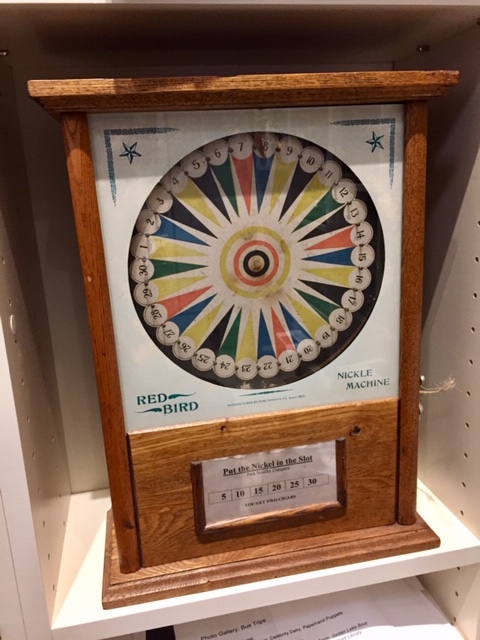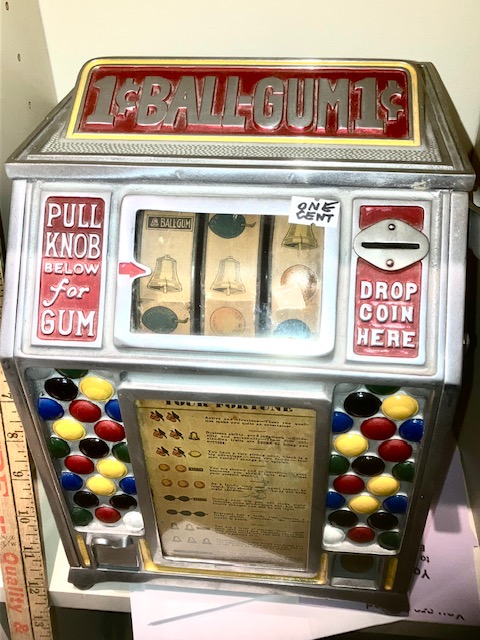
Was $895 - NOW $595
($69 west of Denver)

We also have:
.
.
.
.
 Was $895 - NOW $595 ($69 west of Denver) .
| .
| .
| .
| .
|  |
.
.
 SOLD .
| .
| .
| .
| .
|  Was $495 - NOW - $425 |
.
To Order: use SECURE ORDER FORM
or call 202-213-1585 (10 am - 9 pm East Coast Time)
Other Inquiries, email: durham@GameRoomAntiques.com
.
.
. .
.
Even though trade stimulators were extensively used in the 1890s, they weren't called trade stimulators until 1907 when the Mills Novelty Company used the term in one of its catalogues.
The most popular early trade stimulators were the Bicycle and the Fairest Wheels. With both of these machines the weight of a penny caused a wheel to rotate and, like a carnival wheel, the player hoped the wheel would stop on a high number so that he could win multiple cigars or other merchandise. Other popular machines during this era were the penny drops and flips.
The bartender or store attendant paid winners over the counter since trade stimulators did not automatically pay out cash like slot machines. Winners usually received free merchandise, such as a cigar or a pack of cigarettes. Some trade stimulators had automatic token dispensers so that the store attendant didn't have to be called every time there was a winner. These tokens were stamped with the store's name or the winning value, such as "Good For A Free Cigar" or "Good for 5ó in Trade".
Although trade stimulators became less popular for a period, their popularity rebounded in the 1930s. Many operators utilized them instead of slot machines because there were lower in cost and smaller in size, as well as needing fewer repairs and posing less legal problems. By the late 1930s, trade stimulators were increasingly becoming known as counter games.
Many trade stimulators, especially those made in the 1930s and 1940s, also dispensed gumball. The gumball feature allowed operators to claim that the stimulators were vending machines and not gambling devices. Operators claimed that the machine were made to dispense gumballs for a coin and that the spinning reels were for amusement purposes.
The 1930s trade stimulators were generally ornate and appealing to the eye, while in the 1940s they became more utilitarian. After the Johnson Act, which made gambling machines illegal, was passed in the early 1950s, merchants started using punchboards instead of trade stimulators.
For values, go to Antique Slot Machine Price Guide
For a list of trade stimulators available for sale, visit the Trade Stimulator Sales List
For a list of Trade Stimulator Manufacturers and Game Names, visit the Manufacturer and Game List Web Page
Copyright: 1996 Ken Durham.
. .
.
For more information on:
Who We Are & Our Privacy Policy
Ken DurhamMore Trade Stimulators
Decorating Your Gameroom
HISTORY OF TRADE STIMULATORS
Trade stimulators, as the name implies, were designed to stimulate business either by attracting customers into a specific store or by giving the customer another reason to spend his loose change when paying for merchandize.
Go back to Sales Lists, Wanted Lists and Trade Lists menu.
Go back to GameRoomAntiques
GameRoomAntiques
Email:
durham@GameRoomAntiques.com
Secure Order Form